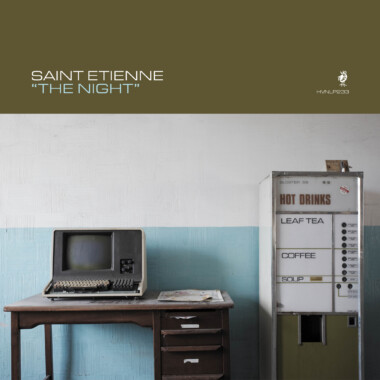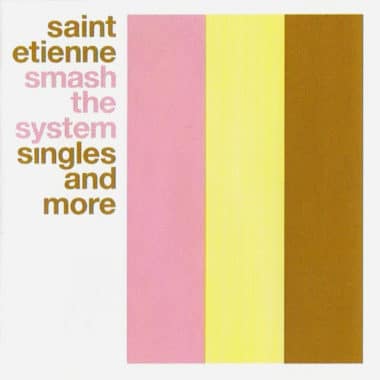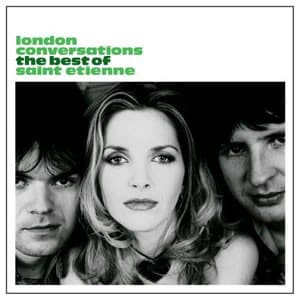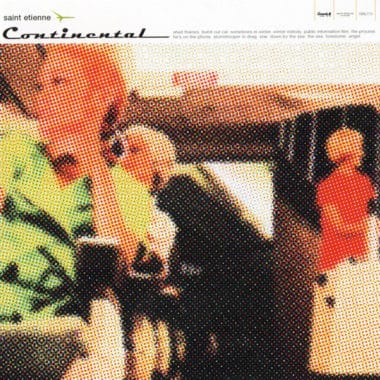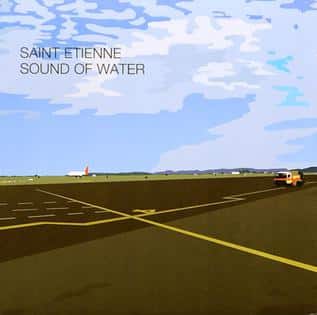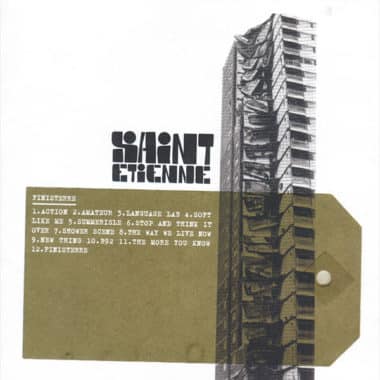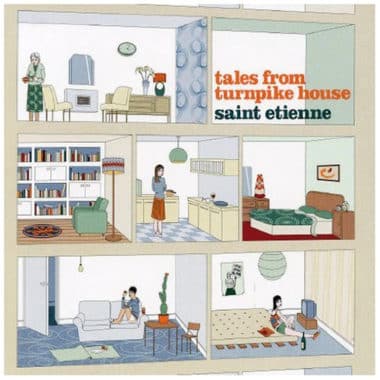FAREWELL FROM SAINT ETIENNE
Bob Stanley, Pete Wiggs and Sarah Cracknell call last orders on a three-decade career, with their 13th and final album on Heavenly Recordings, International.
‘And 30 odd years later We seem suave and refined but we’re not the dandy highwaymen You might expect to find…’
Saint Etienne’s new album, International, is their final album-length statement, after the group’s 35-year excursion through pop. A dreamlike drift with friends and collaborators, International features cameos from the higher echelons of pop – 80s chart heroes, electro, acid house and all points in-between, from Vince Clarke to Nick Heyward, Confidence Man to Erol Alkan, Chemical Brothers, Orbital, Doves and Xenomania, through to the lesser known, but equally exhilarating Bradfordians Augustin Bousfield and Flash Cassette (an artist described as “sitting somewhere between Funkadelic and a SEGA Mega Drive”). Saint Etienne are the 90s band who never left us, never imploded, and never adhered to clichéd excess. They are a testament to getting along, getting on with creating something new and, of course, getting away with it.
With a career spanning three and a half decades, their recorded output comprises a rich discography of remixes, compilations, soundtracks, box sets, albums, singles, and EPs. Beginning with the Mercury-nominated Foxbase Alpha in 1991, they were famously known for their cover version of Neil Young’s ‘Only Love Can Break Your Heart’ – a Balearic classic which arguably transcended the original – followed by a series of canonical records including So Tough, the groundbreaking folktronica of Tiger Bay and the film/album project Finisterre. Just last year, they created an immersive ambient album with The Night, described by Simon Price as “layered tranquility, offering calm to restless minds and a gentle respite from modern life’s relentless pace.”
The Times once wrote that Saint Etienne “deftly fused the grooviness of Swinging Sixties London with a post-acid house backbeat,” yet that description, although applicable in the early days, doesn’t remotely capture the broad depth of their career. On record, there was the anthemic ‘Seven Ways to Love’ (under the name Cola Boy), the Xmas single with Tim Burgess, and their various collaborations with Shara Nelson, Paul Van Dyk, Kylie, David Essex and Richard X. Add to that list the unreleased duet with Parker Posey or their appearance in The Sopranos episode, ‘I Dream of Jeannie Cusamano.’ Outside of the studio, they were also artists-in-residence at London’s Southbank Centre and worked on a list of acclaimed films including the BFI backed How We Used To Live with director Paul Kelly and the recent I’ve Been Trying to Tell You with Alasdair McLellan.
But you don’t need to know about this, of course, because Saint Etienne are a bonafide institution that extends far beyond a dry list of thirteen album titles. They are respected and cherished as a group who stood on their own feet and survived, never entering the Faustian pact with major labels, preferring to work with independents (Heavenly, Sub Pop, Creation) and keep their vision intact – modernism, delivered with integrity, wit, and originality that is always, intrinsically the sound of Saint Etienne.
So what is the key to their happy marriage? Why draw a line under it now? “I like career arcs” says Bob. “It feels like a natural conclusion – with this album there’s a sense of getting the school year back together. It’s one closing act that ties the loose ends up.”
“We all have different reasons for why it’s time to say goodbye,” Sarah explains, “but for me I always wanted to finish on a high, I didn’t want to dribble off. We wanted this to be a peak. There’s going to be a lot of tears. There are no egos, which is the fundamental thing. There’s no bickering or arguing, we’ve never fallen out or had a row – ever.”
Pete enthusiastically believes the key to the trio’s longevity is the pursuit of fun, and their relative non-celebrity status.
“We may have been richer on a major, but we may also haveburnt out early,” he says. “Being independent has given us more control, more choice andsome of those decisions might be commercially bad, but artistically good. I still get excited about new technology, and I’m a bit like a kid internally, so I haven’t changed that much since we started out.”
“I’ve been friends with Pete since we were in pushchairs,” recalls Bob. “We never did that thing of touring the US for six months; we took time off when we probably shouldn’t have. It meant we stayed friends, which was important, and every time we started a new project it was fresh.” Now living in the Yorkshire mill village of Saltaire, he reflects on the group’s trajectory. “We only made records when we had a strong idea about what the album should sound like. We had more autonomy that way. We wanted to make an album at Tambourine Studios in Malmo – we could do that. Or make a film and accompanying album about London in the early 21st century. We made sure we always had control.”
Having the will to say ‘no’ and only record when inspiration truly appeared is a sensibility that led straight to the recording of International. Mixed and recorded in Brighton with Tim Powell
(best known for his Xenomania forays with Sugababes, Girls Aloud and Pet Shop Boys) International was written in tandem with their previous ambient release, The Night, acting almost as an antidote to that album’s nocturnal, continuous sleep aid that embodied each
side. This final album, in contrast, is almost entirely up-tempo. The idea of distilling the group to its pure electro-pop essence was a driving force behind its creation. Modern and contemporary, but not overly hip. By exploring some of the earlier sounds of their career, it is tinged with melodies and melancholy capturing the era when it all began. “This is where we are, and who we’ve worked with, and the place we’ve arrived at,” says Bob. With a nod to Foxbase Alpha, its interludes are read in different languages and feature minor anecdotes from the band’s career recorded by actor Caroline Catz, broadcaster Colin Murray, the author Isabel Waidner, their frequent collaborator Debsey Wykes and presenter Katie Puckrick, who interviewed Pete in an inebriated state on Channel 4 once upon a time. “As it was our last record, we managed to pull in some of our favourite people. It’s like throwing a landmark birthday party,” laughs Pete. Add to that a rollcall of fabled producers and songwriters from the 1980s to 2025, and sleevenotes by the unparalleled critic Jonathan Meades, and you have an album that stands up as a celebration of the different worlds – from city to suburb, bedroom to dancefloor, pop to willful obscurity – that have embodied their recorded output.
International’s first single Glad is joyful, a record to welcome the new day in with. The
waterfall of guitars and distinctive beats are unmistakably based around the tectonic plates where the Chemical Brothers and Doves meet. The anthemic Dancing Heart is equally uplifting and melancholic, the terrain this group has always occupied: ‘Moments like these they don’t last forever / Turn them to memories.’ The Go Betweens (a duet with Haircut 100’s Nick
Heyward) resembles a lost classic from the vaults: ‘You were young, and I was hopeless’,
whereas Sweet Melodies (with Erol Alkan) is the sophisticated sound of a long summer
night in the city. It is blissful and hypnotic, and was influenced by The Commodores’
‘Nightshift’, their tribute to Marvin Gaye after he died – in response this is Saint Etienne’s eulogy to a recently deceased songwriter.
The synthetic glitter funk of Save it for a Rainy Day features Flash Cassette, an enigmatic underground figure from Bradford. Fade’s distinctive romantic breakbeat is wistful and aquatic. Confidence Man’s Brand New Me duet with Janet Planet is an uplifting, bright, sugar-soaked beach soundtrack. Take Me to the Pilot (with Paul Hartnoll) is a slice of deep, shimmering slamming acid. The poignant, emotive tale of a passion that could not exist embodies Two Lovers, a song written with synth legend Vince Clarke.
Why Are You Calling is a dub heavy, drama-laden 70s noir whereas He’s Gone chases the lost elation of youth, heartbeats rising, in the ecstatic penultimate track. Echoing their debut album, Colin Murray reads the Richard Whitely Countdown conundrum in The Last Time, their touching grand finale: ‘We all signed up to Facebook / Around ‘08 ‘09 / And looked up friends from high school / To see what we could find / But we had nothing in common / And we quickly realised / We’d see photos of their holidays / Until the day we died.’
So now that the music’s over, what’s next for Saint Etienne? “I really don’t know what the future holds after this record, I might just stop and smell the roses for a bit” Sarah confesses. Pete, meanwhile, has been working a poetry and music project, and a film soundtrack. As for Bob, he’s busy writing a couple of books, and will no doubt be found digging through crates of obscure 45rpms at record fairs across the country. When asked about advice for young musicians starting out, it is Sarah who has the very last word: “I started out when I was 15. I loved performing, writing songs and singing. I’d have given myself the same advice then: be true to yourself and follow the things that you love. Stay independent and always stick to your guns.”
Adelle Stripe, West Riding, May 2025

 Buy from the Shop
Buy from the Shop

